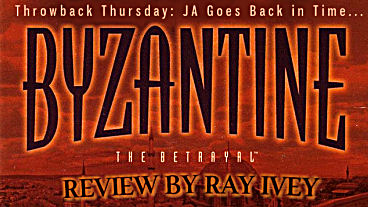
Throwback Thursday: Byzantine: The Betrayal
Note: Review was originally posted December 9, 1999.
Here’s yet another first-class adventure game that never got the attention it deserved.
In Byzantine, you play an American investigative reporter (sex undetermined, a very nice touch) who’s rushed to Istanbul after receiving messages from a friend there. Your friend, Emre, claimed he was onto a huge story that he wanted you to cover.
Unfortunately, the minute you get there, you find that your friend has gone missing. Before you can say “Constantinople,” you’re caught up in an extremely dangerous web of intrigue that includes smuggling and murder.
The format of this exciting game is first-person point-and-click, and the visuals are done with a combination of photographs, video, and computer graphics.
Le me go on record once again and say that I like games that have an valid educational element. Therefore, one of the big joys of this game, which was produced by the Discovery Channel, is that you actually get to explore Istanbul. You move through photorealistic recreations of mosques, palaces, and museums. Never having had the chance to visit Istanbul myself, I welcomed this opportunity.
Byzantine proceeds with the traditional structure of pursuing clues through interviewing people and gathering objects. Movement is facilitated through the use of a beautiful map of the city, with new locations opening up as your investigation uncovers new details.
Very early in your investigation, you learn the shocking truth that the evil persons your friend Emre was investigating are both highly placed and highly dangerous. The sense of danger provides a real dramatic tension throughout the game.
The game has an entertaining bunch of characters (played largely by Turkish actors), including a suspicious but intelligent police detective, a merchant uncle of Emre’s who may know more than he’s telling, a museum curator who may be in cahoots with the smugglers, and a computer science grad student who becomes your unwilling accomplice. The game’s conversation trees are exceptionally intelligent and convincing, moving the story forward in a compelling manner.
The story is so fun, in fact, that I want to reveal as little of it as possible.
Another virtue this game boasts is an innovative and helpful user interface, which helps you keep track of characters, notes, and saved games in one handy “notebook.”
If these features–a terrific storyline, a smooth and elegant interface, strong game structure, and an exotic and intriguing setting–were all Byzantine had going for it, it would be a very solid game indeed.
However, there’s one more element to this game that pushes it right over the top and onto my All Time Greats List. And that is the use of a virtual reality simulator.
I have come across the virtual reality gimmick in several games, most notably in Ripper and Nightlong,and I must say that, as gimmicks you can use in building an adventure game, it’s a darn good one. In the case of Byzantine, it’s simply a masterstroke.
Again, without giving too much away, let me just say that you have to use a virtual reality simulator to help you foil the smugglers. This involves scanning sections of the real, present-day buildings and artifacts, using the scans to help complete VR recreations, and then exploring the resulting recreations in order to discover new facts. It’s not only a chance for the graphic artists to go crazy, it’s simply an irresistible feature to an already good story.
I played the game with a friend who works in a museum, and she felt she had died and gone to Game Heaven. Playing out across seven CDs, the game is large, rich, and of appropriate length. By the time we had finished the game, we felt we had actually been to Istanbul and foiled the smugglers ourselves. It was one of the most satisfying games I’ve played.
Final Grade: A
System Requirements:
Pentium 90
16 MB RAM
4X CD-ROM
SVGA
Mouse
Sound board
Windows 95

Leave a Reply